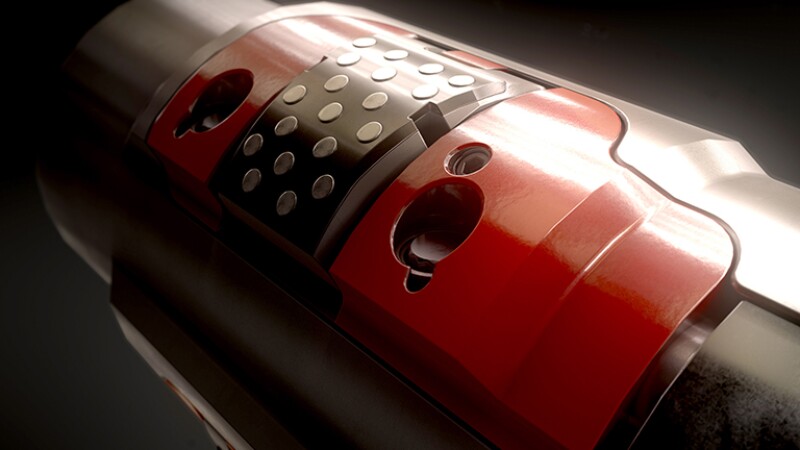For nearly a century, conventional directional drilling served as the benchmark for drilling nonvertical wellbores. It enabled operators to access multiple parts of a reservoir from a single surface location, reducing the overall environmental impacts. Traditional directional drilling used some type of nonrotating bent sub to tilt the drill bit in a different direction from the central axis.
But with the demands of the modern energy industry driven by the unconventional horizonal well market, the industry needed a step change. Operators required a system that could precisely steer through extended-reach wells, often traversing complex trajectories, with precision control and greater reliability. The evolution of rotary steerable systems (RSS) and logging-while-drilling (LWD) technology in the early 2000s addressed this demand by deploying fit-for-purpose tools and services to improve the economic viability of oil and gas fields around the world.
High-Performance Drilling With Full Directional Control
With more operators needing an RSS system that could drill through longer horizontals and deliver quality wellbores in as few runs as possible, Weatherford recognized the demand and responded with the Magnus RSS. Using a push-the-bit design, the system combines reliable, high-performance drilling with precise directional control to enable operators to extend the performance of each drilling run, providing faster drilling, better wellbore quality, and high‑quality measurements.
Directional drilling requires tools to stay in the wellbore for extended periods of time. To keep costs as low as possible, the optimal solution is to perform all drilling operations in one run. To account for the downhole stresses, a rugged design was developed for the RSS. A streamlined design, featuring a ¼-in. undergauge stabilizer and 20% junk-slot area, a fully rotating bias unit, minimal bottomhole assembly (BHA) stabilization, and an optimized junk-slot area combine to reduce the risk of expensive stuck-pipe events. The system also incorporates metal-on-metal piston seals in the mud-actuated pad, enhancing mechanical integrity in harsh and high-pressure drilling environments and greater overall system reliability.
Operators also need the ability to precisely steer the bit to stay on the well plan no matter if the plan requires verticals, curves, or laterals. Three independent pads and valves provide proportional control and allow the pads to fully retract for reaming, cement/shoe drilling, or tight‑hole applications. This independence also provides redundancy in the system in the event of pad or valve failure. The three pads actively manage the direction through the entire wellbore and achieve a true-inclination hold in the lateral.
In many conventional directional drilling operations, even a successful run can leave the wellbore in need of underreaming to prepare it for the installation of contingency liners and casing or completions equipment. Ideally, to optimize drilling efficiency, the directional drilling and underreaming should be performed in the same run. To meet operators’ desire for hole enlargement while drilling, our engineers developed the RipTide drilling reamer, which is often coupled with the Magnus RSS, to drill a smooth, concentric underreamed hole to total depth in one trip.
Field-proven in every asset type from unconventional to deepwater, the drilling reamer enlarges borehole up to 44% beyond bit diameter and delivers high-quality, completion‑ready wellbores. The reamers feature a mass‑balanced, triple-cutter-block arrangement that works with the RSS to minimize vibrations while drilling. For greater operational flexibility, the reamers can be activated via a mechanical ball-drop system, pressure-cycle activation, or electronic radio‑frequency identification (RFID) tags. The RFID system provides unlimited downhole activation cycles, full through‑bore internal diameter, and gives operators the ability to place multiple reamers in the drilling assembly.
Accurate well placement is supplied by LWD tools that steer the RSS with real-time near-bit data for improved overall productivity. Anchored by a suite of LWD tools—including the GuideWave azimuthal resistivity tool, the SineWave microimager, the CrossWave azimuthal sonic tool, and the HEL hostile-environment logging tool—continuous azimuthal gamma ray and inclination measurements taken in as little as 6 ft behind the bit enable effective wellbore placement and geosteering changes to stay in the target zones. Self-regulated adjustments using an electronic system and autopilot functionality provide closed‑loop control for course correction during drilling. A bidirectional communication system operates in real time without interrupting drilling, sending control signals to the RSS, and then verifying the information so that steering adjustments immediately take effect.
The RSS works with standard drill-bit designs, enabling operators to avoid lengthy lead times and reduce the need for additional inventory. A proportional control system in the RSS makes drilling adjustments to minimize tortuosity for a smooth, high-quality wellbore that can increase the efficiency and reduce the costs of future well-construction operations. With a high-dogleg capability of up to10° per 100 ft (33 m), the RSS can build the curve section, eliminate correction runs, and contact the pay zone sooner. An electronic control system samples data at rapid rates to confirm the toolface orientation and deliver full control.

Demonstrated Results in Multiple Environments
Romania—Offshore horizontal well. In an offshore horizontal well, an operator needed the RSS to improve performance compared to offset wells in the field, specifically by increasing the on-bottom rate of penetration (ROP), reducing stick/slip and vibration levels, minimizing borehole tortuosity for post-drilling operations, and, ideally, achieving zero nonproductive time (NPT).
Through pre-job planning, it was determined that the RSS coupled with advanced LWD technologies would address all challenges. The technology was deployed on a tailored BHA design focused on torque and drag, hydraulics, and vibration optimization. Upon deployment, the RSS’s near-bit inclination coupled with LWD resistivity and sonic imaging minimized reservoir uncertainties, maintained pay-zone contact, and ultimately landed the well. A high-temperature azimuthal gamma ray sensor identified formation tops in real time while LWD pressure measurements provided live information on downhole hydraulics and fluid performance.
The RSS kicked off from the whipstock and drilled 9,249 ft (2819 m) in one run, over 394 operating hours (16 days). The performance saw a 26% increase in average ROP and a 50% reduction in stick/slip and vibration levels compared to offset wells. The RSS worked against a formation with a 5–10° dip angle to minimize borehole tortuosity for post-drilling operations and intercepted all planned geological targets to remain within a target window of 32.8 ft (10 m). The increased ROP, reduced stick/slip and vibration, and zero NPT delivered the well 9 days faster than previous offset wells, an approximate savings of $2.5 million.
Mexico—Onshore, s-type oil well. In an onshore, s-type oil well, the operator needed to drill an 8½×9½-in. hole section through the Cretaceous formation while staying within 16 ft (5 m) of the planned well trajectory and maintaining the dogleg severity less than 3.0°/100 ft (30 m) to minimize borehole tortuosity and deliver good hole quality. To counteract torsional vibration while improving drilling efficiency, the team recommended a newly developed, fit-for-purpose bit with specialized cutter technology, a request accomplished with the RSS’s ability to adapt to any drill bit. The RSS and the RipTide reamer were both included on the BHA, guided by LWD tools. The RSS drilled 5,367 ft (1636 m) to TD at 13,741 ft (4107 m) with zero NPT. The reamer activated and deactivated multiple times using RFID technology. Compared to a similar operation with separate drilling and reaming runs, the combination saved 2 days of rig time valued at $270,000.
Mexico—Offshore development well. The well plan called for drilling through several intercalated formations with high compressive strength. According to offset well information, the main challenges were fluid losses, influx, high drilling torque, and torsional vibrations. Significant damage in directional tools related to corrosion has also been experienced in previous jobs. With enough stability points to mitigate vibrations and ensure operation continuity without sacrificing steerability, the Magnus RSS was recommended to minimize the stabilization points on the BHA. The 3,271‑ft (997‑m) run was delivered in 134 circulating hours, eliminating a second run, and saving a full day of rig time and associated costs, approximately $73,000.
Kuwait. An operator in Kuwait needed to drill and log an 8½-in. section of a deviated well in a single run. When using conventional motorized drilling technology, the operator had often required more than one trip to drill previous 8½‑in. sections in the field because of high stick/slip, severe shock and vibration, and poor penetration rates. In addition, the operator had to perform separate wireline runs to log the wellbore, a process slowed because of differential sticking in the depleted-pore-pressure reservoir. Complicating this operation was the plan to run a 7-in. liner in the same 8½-in. section as quickly as possible after the section was drilled.
The RSS was paired with a triple-combo LWD suite of tools including gamma ray, resistivity, density, and neutron. With its fully rotating body, minimal BHA stabilization, proportional steering control system, and optimized junk‑slot area, the RSS reduced the possibility of stuck‑pipe incidents and achieved optimal hole cleaning. The LWD suite helped to minimize openhole exposure by logging the wellbore during drilling operations.
The combination of the RSS and the triple-combo completed the drilling section in a single run and eliminated the need to run wireline logs and the associated wiper trip. Instead, the recommended approach provided high-quality formation evaluation logs in real time while drilling to save the operator a total of 39 hours of rig time, approximately $40,000. The smooth wellbore profile as delivered by the proportional steering control of the RSS resulted a clean trip and minimal drag when running the 7-in. liner to bottom. Following this success, the operator followed a similar approach to avoid risks in other wells and deliver them ahead of plan.

Julio Loreto is vice president of drilling services at Weatherford. He has been dedicated to the oil and gas industry for over 25 years with the ability to evaluate business environments to implement cost-effective solutions in multicultural and multisite projects. Loreto is enthusiastic on social responsibility, having personally supported multiple projects to enhance the living conditions of the communities where Weatherford works.

Brad Zukiwsky is the global product manager for RSS at Weatherford, based in Houston. Zukiwsky has nearly 20 years of experience in the drilling services business with a background specializing in product development, operations management, and business development. He has held various management positions in several countries around the world and was most recently responsible for launching the Magnus RSS as product champion.
Aly Bassiouny is the MLWD product manager for Weatherford International, based in UK. He has over 21 years of industry experience in a variety of roles for both service and operating companies. For the past 12 years, his effort has been concentrated on measurement and application of logging-while-drilling technologies. He began his career by joining BP (GUPCO) in 1999 and has worked in operation log analysis and petrophysics. He has published numerous technical papers. Bassiouny holds a double BS degree in geology and geophysics from Ain Shams University, Egypt. He is a member of SPE, SPWLA, and AAPG.

Onochie Michael Okorie is currently the global product line manager for directional drilling and borehole enlargement at Weatherford. He has 11 years of experience in the oil and gas industry and, prior to joining the global management team, he has held several management positions leading applications in engineering, operations, and business development across Middle East, North Africa, and Asia.

